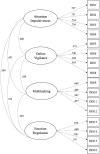Exploring the Dimensions of Smartphone Distraction: Development, Validation, Measurement Invariance, and Latent Mean Differences of the Smartphone Distraction Scale (SDS)
- PMID: 33762981
- PMCID: PMC7982468
- DOI: 10.3389/fpsyt.2021.642634
Exploring the Dimensions of Smartphone Distraction: Development, Validation, Measurement Invariance, and Latent Mean Differences of the Smartphone Distraction Scale (SDS)
Abstract
Background: Distraction is a functional emotion regulation strategy utilized to relieve emotional distress. Within the attention economy perspective, distraction is increasingly associated with digital technology use, performance impairments and interference with higher-order cognitive processes. Research on smartphone distraction and its association with problematic smartphone use is still scarce and there is no available psychometric assessment tool to assess this cognitive and emotive process parsimoniously. Method: The present study reports the development and evaluation of the psychometric properties of the Smartphone Distraction Scale (SDS) through exploratory and confirmatory factor analysis, construct validity, gender invariance, and latent mean differences. The study was conducted in a sample of British university students (N = 1,001; M = 21.10 years, SD = 2.77). Results: The 16-item SDS was best conceptualized in a four-factor model solution comprising attention impulsiveness, online vigilance, emotion regulation, and multitasking. Construct validity was established using relevant psychosocial and mental health measures, with SDS scores being moderately associated with deficient self-regulation and problematic social media use. Gender measurement invariance was achieved at the configural, metric, and scalar levels, and latent mean differences indicated that females had significantly higher means than males across all four SDS latent factors. Discussion: The SDS presents with several strengths, including its theoretical grounding, relatively short length, and sound psychometric properties. The SDS enables the assessment of distraction, which appears to be one of the pathways to problematic smartphone use facilitating overuse and overreliance on smartphones for emotion regulation processes. The assessment of distraction in relation to problematic use in vulnerable populations may facilitate interventions that could encourage metacognition and benefit these groups by allowing sustained productivity in an increasingly disrupted work and social environment.
Keywords: attention; distraction; smartphone distraction scale; smartphone use; social media use.
Copyright © 2021 Throuvala, Pontes, Tsaousis, Griffiths, Rennoldson and Kuss.
Conflict of interest statement
The authors declare that the research was conducted in the absence of any commercial or financial relationships that could be construed as a potential conflict of interest.
Figures
Similar articles
-
Smartphone Distraction: Italian Validation of the Smartphone Distraction Scale (SDS).Int J Environ Res Public Health. 2023 Aug 2;20(15):6509. doi: 10.3390/ijerph20156509. Int J Environ Res Public Health. 2023. PMID: 37569049 Free PMC article.
-
Psychometric Properties of the Smartphone Distraction Scale in Chinese College Students: Validity, Reliability and Influencing Factors.Front Psychiatry. 2022 Jun 16;13:859640. doi: 10.3389/fpsyt.2022.859640. eCollection 2022. Front Psychiatry. 2022. PMID: 35782432 Free PMC article.
-
Validation of the Chinese version of the Smartphone Distraction Scale.Heliyon. 2024 May 23;10(11):e31807. doi: 10.1016/j.heliyon.2024.e31807. eCollection 2024 Jun 15. Heliyon. 2024. PMID: 38882330 Free PMC article.
-
Emotional and Behavioural Factors Predisposing to Internet Addiction: The Smartphone Distraction among Italian High School Students.Int J Environ Res Public Health. 2024 Mar 22;21(4):386. doi: 10.3390/ijerph21040386. Int J Environ Res Public Health. 2024. PMID: 38673299 Free PMC article.
-
Development and Validation of the Youth Sociopolitical Action Scale for Social Media (SASSM).Adolesc Res Rev. 2023 Mar 1:1-14. doi: 10.1007/s40894-023-00208-w. Online ahead of print. Adolesc Res Rev. 2023. PMID: 37360251 Free PMC article. Review.
Cited by
-
Understanding the relationship between smartphone distraction, social withdrawal, digital stress, and depression among college students: A cross-sectional study in Wuhan, China.Heliyon. 2024 Jul 30;10(15):e35465. doi: 10.1016/j.heliyon.2024.e35465. eCollection 2024 Aug 15. Heliyon. 2024. PMID: 39166051 Free PMC article.
-
Modelling the contribution of metacognitions and expectancies to problematic smartphone use.J Behav Addict. 2021 Sep 28;10(3):788-798. doi: 10.1556/2006.2021.00066. J Behav Addict. 2021. PMID: 34613932 Free PMC article.
-
The Influence of Smartphone Use on Tweens' Capacity for Complex Critical Thinking.Children (Basel). 2023 Apr 8;10(4):698. doi: 10.3390/children10040698. Children (Basel). 2023. PMID: 37189947 Free PMC article.
-
Relationship Between Problematic Smartphone Use and Graduate Students' Research Self-Efficacy: A Moderated Mediation Model.Behav Sci (Basel). 2024 Dec 13;14(12):1191. doi: 10.3390/bs14121191. Behav Sci (Basel). 2024. PMID: 39767331 Free PMC article.
-
Smartphone overuse and distraction: which relationship with general well-being across different generations?BMC Public Health. 2025 Feb 3;25(1):427. doi: 10.1186/s12889-024-21269-z. BMC Public Health. 2025. PMID: 39901083 Free PMC article.
References
-
- Gross JJ. Emotion regulation: current status and future prospects. Psychol Inquiry. (2015) 26:1–26. 10.1080/1047840X.2014.940781 - DOI
-
- Mollenkopf D, Gaskill M, Nelson R, Debose CD. Navigating a new normal during the COVID-19 pandemic: college student perspectives of the shift to remote learning. Int J Technol Higher Educ. (2020) 17:67–79. 10.18162/ritpu-2020-v17n2-08 - DOI
LinkOut - more resources
Full Text Sources
Other Literature Sources



